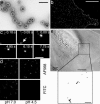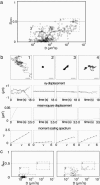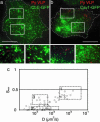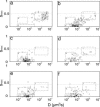Single-particle tracking of murine polyoma virus-like particles on live cells and artificial membranes
- PMID: 16219700
- PMCID: PMC1257700
- DOI: 10.1073/pnas.0504407102
Single-particle tracking of murine polyoma virus-like particles on live cells and artificial membranes
Abstract
The lateral mobility of individual murine polyoma virus-like particles (VLPs) bound to live cells and artificial lipid bilayers was studied by single fluorescent particle tracking using total internal reflection fluorescence microscopy. The particle trajectories were analyzed in terms of diffusion rates and modes of motion as described by the moment scaling spectrum. Although VLPs bound to their ganglioside receptor in lipid bilayers exhibited only free diffusion, analysis of trajectories on live 3T6 mouse fibroblasts revealed three distinct modes of mobility: rapid random motion, confined movement in small zones (30-60 nm in diameter), and confined movement in zones with a slow drift. After binding to the cell surface, particles typically underwent free diffusion for 5-10 s, and then they were confined in an actin filament-dependent manner without involvement of clathrin-coated pits or caveolae. Depletion of cholesterol dramatically reduced mobility of VLPs independently of actin, whereas inhibition of tyrosine kinases had no effect on confinement. The results suggested that clustering of ganglioside molecules by the multivalent VLPs induced transmembrane coupling that led to confinement of the virus/receptor complex by cortical actin filaments.
Figures





References
Publication types
MeSH terms
Substances
LinkOut - more resources
Full Text Sources
Other Literature Sources

